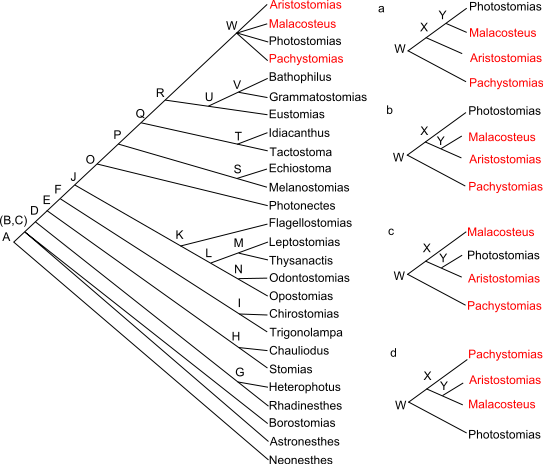
and systematics
| Palaeos |  |
Cladistics |
| Phylogeny and systematics |
Cladistics Home |
| Page Back | Unit Up: Phylogeny and Systematics | Page Next |
| Unit Back: Evolutionary systematics | Glossary | Unit Next: Molecular phylogeny |
 From Wikipedia. Cladogram of stomiid fishes, according to Fink WL. 1985. Phylogenetic interrelationships of the stomiid fishes (Teleostei: Stomiiformes). Miscellaneous Publications of the Museum of Zoology, University of Michigan 171:1-127. The resolved cladograms of this topology have a length of 496 and consistency index of .494, without the seventy-eight generic apomorphies. With generic apomorphies included, the length is 574, the consistency index is .563. A-D show alternative resolved cladograms for Malacosteus-Pachystomias-Aristostomias-Photostomias group. For character conventions, see Fink (1985). Diagram and text by Filip em. The letters A to Y represent nodes, the names at the right of the diagram genera. |
Cladistics is a rigorous methodology first developed by German entomologist Willi Hennig in the 50s and 60s as a means of evaluating and reconstructing phylogenetic hypotheses if fossils are lacking (insects have a notoriously poor fossil record). Hennig's work was little known until the late 70s, when it was translated into English and applied in American and British paleontology. It quickly gain popularity as a reaction to evolutionary systematics, and by the 1990s had totally replaced it, at least in the admittedly specialised field of vertebrate paleontology. Many other fields of biological taxonomy, especially botany, have remained staunchly Linnaean (Linnaeus was a botanist). Despite this paradigm revolution, they are two very different systems. One important difference is that evolutionary systematics deals with ancestor-descent relationships, especially in supra-specific taxa, and cladistic trees with sister relationships of individual species, or even, in the case of fossils, individual specimens. Another is that evolutionary systematics is strongly paleontological, emphasising the stratigraphic sequence in the fossil record in deep time, whereas with cladistics, the emphasis is on neontology (extant taxa can provide far more information - e.g. soft tissue, molecular, etc.) and stratigraphic occurrence is phylogenetically unimportant.
Nevertheless, paleontology does play a very important role in cladistics, thanks to the pioneering efforts of vertebrate paleontologists like Jacques Gauthier (Gauthier 1986), Eugene Gaffney, Susan Evans, Michael Benton, and others, what began as an obscure alternative to phenetics and evolutionary systematics came to be the defining paradigm for understanding the evolution of life (first vertebrate, than the tree of life in general). Indeed, when computer-based cladistic analysis came into its own in the 1990s, paleontologists were among the first zoologists to almost wholeheartedly adopt the system (Brochu & Sumrall, 2001).
There are basically two schools of interpretation in cladistics: (a) Phylogenetic Systematics (also known as Hennigian, Numerical or Process Cladism ), and (b) Pattern or Transformed cladism (these latter two are usually synonymised, although Ebach et al 2008 refers to these as distinct), although the arguments between rival schools in the 1980s are long gone, and cladists today generally combine both interpretations.
The availability of cheap, powerful computers to run cladistic analyses means that cladistics has really taken off on the last decade, even if these new cladograms aren't exactly the same as the earlier, 1980s/90s vintage, hand-coded ones. Hence the distinction between old style morphology-only cladistics which consider a smaller number of better known or obvious characters (without cheap and powerful computing it was not practical to do otherwise) and current computer-generated supertrees and supermatrixes coding hundreds of characters and taxa, including both morphology and molecules.
There are several algorithms available to identify the "best" cladogram. Most algorithms use a metric (a mathematical function which defines a distance between elements of a set) to measure how consistent a candidate cladogram is with the data. Most cladogram algorithms use the mathematical techniques of optimization (choosing the best element from some set of available alternatives) and minimization. In general, cladogram generation algorithms must be implemented as computer programs, although some algorithms can be performed manually when the data sets are trivial (for example, just a few species and a couple of characteristics). Algorithms include least squares (minimising the sum of the squares of the errors made in solving every single equation), neighbor-joining, parsimony, maximum likelihood, and Bayesian inference. Some are useful only when the characteristic data are molecular (DNA, RNA); others only when the characteristic data are morphological, others again can be used when the characteristic data includes both molecular and morphological data. (Wikipedia)
In recent years, cladograms have tended to become bigger and more complex. Cladograms can be combined to form supertrees, cladograms of cladograms. Powerful computers make it possible to run cladistic analyses using hundreds of traits and taxa, plotted in supermatrixes. These impressive diagrams have a lot of appeal, especially as regards the goal of large scale tree of life phylogeny, although as with anything they are not without their difficulties.
Cladistics has great appeal to paleo geeks. There is something very cool about being able to construct a genealogical tree of the evolution of a particular group, or all life on Earth, using empirical, repeatable, scientific methodology. Even if the cladograms for the same groups differ in details (or fundamental topology) because of differently weighted characters and differently included taxa. MAK111014, 111018
A few random links: Phylogenetics Primer - Douglas Theobald, (recommended), Introduction to Cladistics - UCMP, also really good, Am I a pattern or transformed cladist? (mail list anecdote on phenetics and cladists); Peter Forey - Cladistics for Palaeontologists (pretty technical). MAK111014
| Page Back | Page Top | Page Next |
